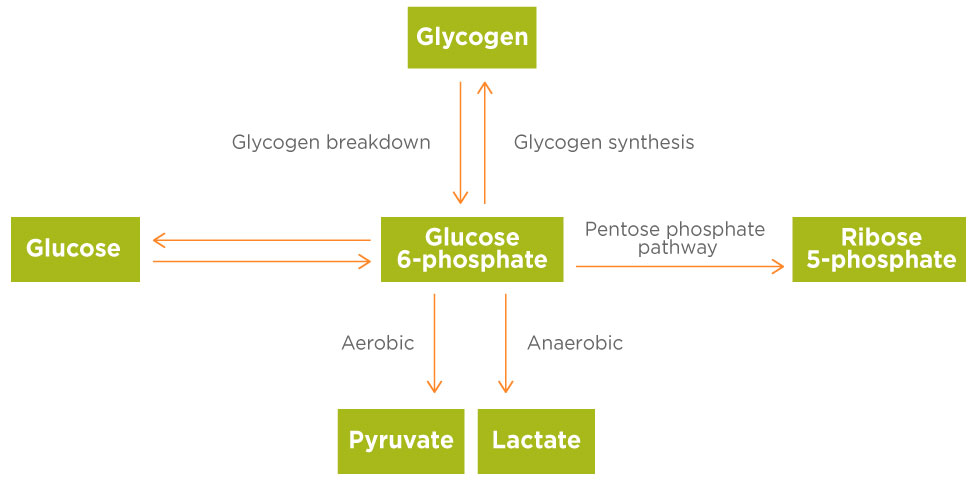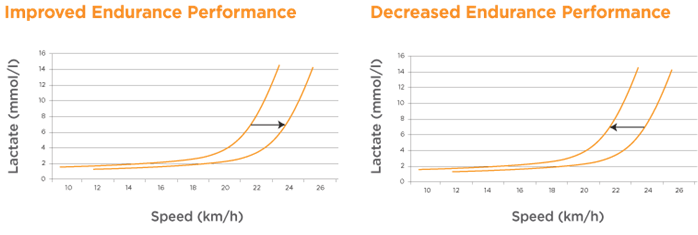For a long time, lactate was seen as a by-product of glycolysis (glucose metabolism) and being primarily responsible for muscular fatigue during exercise.
This misunderstanding arose from early studies showing that lactate increased in blood and muscle tissue in an exercise intensity dependent manner and that lactate production was therefore closely corelated with fatigue levels.
In order to understand how lactate levels relate to sports performance and training regimens, it is necessary to understand the basics of glucose metabolism. During normal muscular activity, glucose is metabolised as an energy source to release energy with pyruvate and 2 H+ ions as the by product. Pyruvate is then utilised in other metabolic processes to generate further cellular energy sources. This is known as aerobic glucose metabolism. As muscle activity increases and oxygen becomes a limiting factor in glucose metabolism, lactate becomes the preferred endpoint of glucose utilisation. This is known as anaerobic glucose metabolism.
 |
| Overview of glucose metabolism Overview of glucose metabolism showing that lactate is part of a complicated cycle of sugar conversions mediated by numerous enzymes. |
Lactate is therefore the ultimate end product of glucose utilisation within the body and it can be used by the body in several ways. Lactate can be converted back to pyruvate to fuel the Krebs cycle (which ultimately produces the biochemical energy source ATP) or lactate can be converted to glucose via gluconeogenesis in the liver.
Active transport of lactate from muscle fibres into the bloodstream fuels these other pathways. Blood lactate levels of approximately 1mM to 2 mM at rest or during moderate exercise are typical. Therefore, the body is able to utilise glucose, pyruvate and lactate as both energy sources and precursors for other metabolic pathways during rest and moderate activity.
During high intensity exercise, increasing glucose metabolism to fuel muscle activity is oxygen dependent and the switch to anaerobic glucose metabolism with lactate production as the endpoint has downstream consequences. Muscles also have a finite capacity to utilise lactate and remove lactate from the muscle fibre. Lactate therefore begins to accumulate in the muscle fibres and eventually in the bloodstream.
With training, the body is able to increase its utilisation of lactate and thus maintain muscle function for longer periods before lactate starts to accumulate in the muscles and subsequently becomes elevated in the blood.
Increased endurance is therefore associated with an increased lactate threshold. Thus the lactate threshold definition is the first increase in blood lactate above the resting level, which is typically between 1 and 2 mM in healthy subjects.
How do athletes from distance runners to swimmers and cyclists achieve an increased lactate threshold? Athletes need to do a mix of speed work and slower endurance training to develop both the aerobic and anaerobic metabolic pathways. This holds for both beginners and elite athletes alike. Sports science has utilised the lactate threshold test to define specific training plansd for many sports.
| Did you know? |
At her peak, former marathon record holder Paula Radcliffe could run at 18.5km/h before her blood lactate rose above normal. |
 |
Most training plans are designed to gradually increase distance and speed, without overstressing the body. For the recreational runner, this would typically mean 2 or 3 short runs during the week and a longer run at the weekend that, as the weeks progress, gets longer. These runs should be at a pace that is easy to maintain and will build endurance, that is the ability to exercise at that pace for longer.
Training plans will also incorporate a speed element aimed at reducing the time required to cover a given distance. These speed elements should be a mix of interval sessions during your longer run (e.g. by increasing your pace during the last minute of each mile) and speed specific sets (e.g. 500m with 2 min rest at easy jog 4 times, repeat next week and see if times have improved, if they have improved, add another set or increase the distance and reduce the recovery period). These speed sessions should be at a moderate to moderately hard pace.
How does this type of training relate to lactate threshold? The long runs at a pace that is sustainable will typically be at a lactate level that is normal. The speed work pushes your body beyond the lactate threshold and trains your body to better clear lactate from the musculature.
The most efficient way to improve your lactate threshold is with true lactate threshold training. True lactate threshold workouts are performed at a pace that is very close to your specific lactate threshold, typically this is a moderate to moderately hard pace. For the vast majority of runners that intensity level is reached at or just slightly slower than their 10K race pace.
So why not train at that pace all the time? Your lactate pace is a hard pace and it would be both very difficult and unwise to consistently train at a pace that hard. That’s why a mix of endurance-building long runs and stamina-building speed work at varying paces are the ideal way to increase your lactate threshold.
| Did you know? |
Top Olympians have a higher lactate threshold than Olympians finishing in the bottom 25% of their sport? |
 |
These tests are typically called step tests and rely on stepping up the intensity of the exercise effort over 2, 3 or more steps.
In order to track your lactate threshold, you will need a portable lactate meter, lactate sensors, lancets to take blood, a defined distance over which to run and a way of pacing yourself. Ideally, you should have a willing assistant around to take the blood sample and record the results, it’s difficult trying to get the tests done on your own!
A simple step test would look like this:
The pacing in the test is the important factor. The paces need to be incremental but sustainable for the duration of the test. A watch with a pacing function is useful for this type of test or you could run on a treadmill with speed control.
Once you have your results you will need to analyse the data. Software supplied with the portable blood lactate meter will automatically pull data from your meter and plot the results.
This initial data will show you at what pace your lactate threshold is reached and is likely to be at the second or third increase in pace. This will give you a pace to aim for and exceed in your speed sessions. Carry on with your training plan using the pace data to inform your speed sessions.
To track progress, repeat the step test with the same pacing 6-8 weeks later and compare the results. The plotted data should show a move of the threshold to the right indicating that you have increased your blood lactate threshold meaning that you can run at higher paces without accumulating lactate.
 |
| Lactate Curves Explained The chart shows a shift in the lactate curve to the right i.e. the speed/level of exertion at which lactate becomes elevated in the blood in increased. This shift corresponds to increased fitness such that the athlete can perform at higher levels of exertion without accumulating lactate in the musculature. |
|
Lactate is useful tool in treatment decision making. Read our Lactate in medical applications and Lactate for veterinary use guides. |
Copyright © 2024 | Powered by Intergage

Please note: Not all products are available in all countries. Please check availability.
Newsletter
Keep up to date with all our activities, events, exhibitions, promotions, investor news & more.